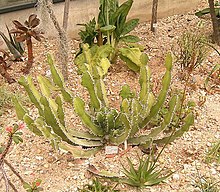Euphorbieae is a tribe of flowering plants of the family Euphorbiaceae.[1] It comprises 3 subtribes and 5 genera.[2] The 3 sub tribes are: Euphorbiinae, Neoguillauminiinae and Anthosteminae. The 5 genus general are: Argythamnia, Caperonia, Chiropetalum, Ditaxis and Chiropetalum.
| Euphorbieae | |
|---|---|

| |
| Euphorbia cactus var. cactus | |
| Scientific classification | |
| Kingdom: | Plantae |
| Clade: | Tracheophytes |
| Clade: | Angiosperms |
| Clade: | Eudicots |
| Clade: | Rosids |
| Order: | Malpighiales |
| Family: | Euphorbiaceae |
| Subfamily: | Euphorbioideae |
| Tribe: | Euphorbieae |
| Subtribes | |
Euphorbieae have many different species of plants including some in the tropic and nontropical areas of the world. Thanks to convergent evolution, these columnar, ribbed flowering plants appear to resemble cacti, although they have different forms and flowers to tell them apart; e.i. a cactus would have spines (leaf tissue) with a rose-like flower, whereas a euphorbieae would have a very basic, 3 petal shape with thorns (stem tissue). Euphorbieae (commonly called Euphorbia) has a sap inside of it - that when it breaks or is cut - comes out of it, and tends to irritate the skin.
Euphorbieae were thought to be a bisexual flower, however, research has shown that there are many male flowers surrounding one female flower.
Genera edit
- Subtribe Anthosteminae
- Subtribe Euphorbiinae[3]
- Subtribe Neoguillauminiinae
See also edit
References edit
- ^ Steinmann, Victor W.; Porter, J. Mark (2002). "Phylogenetic Relationships in Euphorbieae (Euphorbiaceae) Based on ITS and ndhF Sequence Data". Annals of the Missouri Botanical Garden. 89 (4): 453–490. doi:10.2307/3298591. ISSN 0026-6493.
- ^ Park, Ki‐Ryong; Elisens, Wayne J. (2000). "A Phylogenetic Study of Tribe Euphorbieae (Euphorbiaceae)". International Journal of Plant Sciences. 161 (3): 425–434. doi:10.1086/314262. hdl:10365/3219. ISSN 1058-5893.
- ^ Park, Ki-Ryong; Jansen, Robert K. (December 2007). "A Phylogeny of Euphorbieae Subtribe Euphorbiinae (Euphorbiaceae) Based on Molecular Data". Journal of Plant Biology. 50 (6): 644–649. doi:10.1007/BF03030608. ISSN 1226-9239.
- Prenner, Gerhard; Rudall, Paula J. (2007). "Comparative ontogeny of the cyathium in Euphorbia (Euphorbiaceae) and its allies: Exploring the organ–flower–inflorescence boundary". American Journal of Botany. 94 (10): 1612–1629. doi:10.3732/ajb.94.10.1612. PMC 2999901. PMID 21151828.
External links edit
Media related to Euphorbieae at Wikimedia Commons Data related to Euphorbieae at Wikispecies